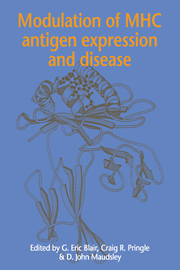Book contents
- Frontmatter
- Contents
- List of contributors
- Preface
- List of abbreviations
- 1 General introduction to the MHC
- 2 Organization of the MHC
- 3 Interactions of cytokines in the regulation of MHC class I and class II antigen expression
- 4 Control of MHC class I gene expression
- 5 Control of MHC class II gene expression
- 6 Modulation of MHC antigen expression by viruses
- 7 Modulation of MHC antigen expression by retroviruses
- 8 Modulation of MHC class I antigen expression in adenovirus infection and transformation
- 9 MHC expression in HPV-associated cervical cancer
- 10 Inhibition of the cellular response to interferon by hepatitis B virus polymerase
- 11 Cellular adhesion molecules and MHC antigens in cells infected with Epstein-Barr virus: implications for immune recognition
- 12 Effect of human cytomegalovirus infection on the expression of MHC class I antigens and adhesion molecules: potential role in immune evasion and immunopathology
- 13 Oncogenes and MHC class I expression
- 14 Mechanisms of tumour cell killing and the role of MHC antigens in experimental model systems
- 15 Manipulation of MHC antigens by gene transfection and cytokine stimulation: a possible approach for pre-selection of suitable patients for cytokine therapy
- 16 Overexpression of MHC proteins in pancreatic islets: a link between cytokines, viruses, the breach of tolerance and insulindependent diabetes mellitus?
- 17 The role of cytokines in contributing to MHC antigen expression in rheumatoid arthritis
- 18 Expression of an MHC antigen in the central nervous system: an animal model for demyelinating diseases
- Index
10 - Inhibition of the cellular response to interferon by hepatitis B virus polymerase
Published online by Cambridge University Press: 11 September 2009
- Frontmatter
- Contents
- List of contributors
- Preface
- List of abbreviations
- 1 General introduction to the MHC
- 2 Organization of the MHC
- 3 Interactions of cytokines in the regulation of MHC class I and class II antigen expression
- 4 Control of MHC class I gene expression
- 5 Control of MHC class II gene expression
- 6 Modulation of MHC antigen expression by viruses
- 7 Modulation of MHC antigen expression by retroviruses
- 8 Modulation of MHC class I antigen expression in adenovirus infection and transformation
- 9 MHC expression in HPV-associated cervical cancer
- 10 Inhibition of the cellular response to interferon by hepatitis B virus polymerase
- 11 Cellular adhesion molecules and MHC antigens in cells infected with Epstein-Barr virus: implications for immune recognition
- 12 Effect of human cytomegalovirus infection on the expression of MHC class I antigens and adhesion molecules: potential role in immune evasion and immunopathology
- 13 Oncogenes and MHC class I expression
- 14 Mechanisms of tumour cell killing and the role of MHC antigens in experimental model systems
- 15 Manipulation of MHC antigens by gene transfection and cytokine stimulation: a possible approach for pre-selection of suitable patients for cytokine therapy
- 16 Overexpression of MHC proteins in pancreatic islets: a link between cytokines, viruses, the breach of tolerance and insulindependent diabetes mellitus?
- 17 The role of cytokines in contributing to MHC antigen expression in rheumatoid arthritis
- 18 Expression of an MHC antigen in the central nervous system: an animal model for demyelinating diseases
- Index
Summary
Introduction
Infection with hepatitis B virus (HBV) can cause either an acute or a chronic hepatitis (Nielsen et al., 1971). Chronic infection is a major health problem affecting over 250 million people worldwide (Ganem & Varmus, 1987). Without treatment, chronic infection with HBV progresses to cirrhosis and/ or hepatocellular carcinoma in over 50% of infected patients. It is still not clear why some infected individuals develop a relatively mild, self-limiting hepatitis whilst others suffer from a prolonged, chronic infection. Recent research suggests that interferon-induced expression of MHC antigens on the surface of infected hepatocytes may play a key role in determining the outcome of infection with HBV.
Viral clearance in acute HBV infection
The majority of healthy adults infected with HBV develops a brief hepatitis, which resolves within a few months and is followed by elimination of the virus. A small percentage of infected adults (less than 5%) and the majority of infected neonates and children (greater than 90%) develop a chronic infection. Research in patients and chimpanzees acutely infected with HBV has provided an insight into the mechanisms underlying the normal eradication of HBV and these studies suggest that induction of MHC expression, by type I interferon (i.e. IFN-α/β), is a key factor in virus eradication.
Following infection with HBV, most adults show a marked increase in the serum concentration of circulating IFN (Ikeda, Lever & Thomas, 1986; Kato, Nakagawa & Kobayashi, 1986; Pignatelli et al., 1986).
- Type
- Chapter
- Information
- Modulation of MHC Antigen Expression and Disease , pp. 251 - 260Publisher: Cambridge University PressPrint publication year: 1995



